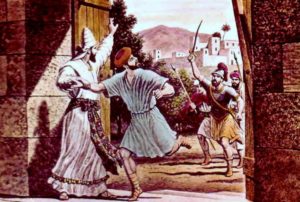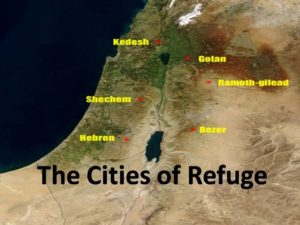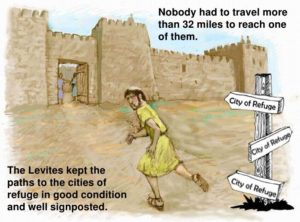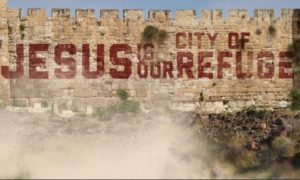What were cities of refuge?
In real life – a man’s blood could be shed in two ways – on purpose or by accident. In biblical times, if someone was killed on purpose, and there were witnesses, then it was murder. They were put to death. Case closed.
But what about ”accidents?” And who determined if it was an accident or not? This is where the cities of refuge came into the picture.
You see – in ancient near east culture, when a man died suddenly and the person with him was suspected of murdering him, it was the duty of the next-of-kin to ”avenge” his family members blood. To track the killer down and make him pay for this.
But what if it truly happened by accident? After the event, with the heat of the moment strong and emotions running high, the next-of-kin might not be open to a rational explanation. Therefore, God set the terms for justice under these conditions.
”Then the Lord spoke to Moses, saying, ”Speak to the children of Israel, and say to them: ‘When you cross the Jordan into the land of Canaan, then you shall appoint cities to be cities of refuge for you, that the manslayer who kills any person accidentally may flee there. They shall be cities of refuge for you from the avenger, that the manslayer may not die until he stands before the congregation in judgment.” (Numbers 35: 9-12)
The Mosaic Law stated that anyone who committed a murder on purpose was to be put to death (Exodus 21:14). But for unintentional deaths, God set aside these cities to which the murderer could flee for refuge (Exodus 21:13). He would be safe from the avenger—the family member charged with avenging the victim’s death (Numbers 35:19)—until the case could go to trial. It is assumed that the Levites would be the most suitable and impartial judges and therefore, their cites were chosen as the place to run to for protection.

If the avenger of blood were to defy the law and take the manslayer’s life anyway, either inside the city of refuge, or outside it after the high priest’s death, then he would himself become a murderer. The Cities of Refuge were six towns where the Levites lived where the perpetrators of manslaughter could claim the right of asylum.
Outside of these cities, there was no protection from blood vengeance. The Torah names the six cities as being cities of refuge:
On the eastern side of the Jordan: Golan, Ramoth, and Bosor.
On the western side: Kedesh, Shechem, and Hebron.

The Talmud states that the roads to these cities were not only marked by signposts saying “Refuge”, but the roads were twice the regulation width—and were particularly smooth and even, in order that fugitives were as unhindered as possible.

A chapter in the Book of Joshua (chapter 20) also reiterates the regulations for the cities of refuge, adding that when a perpetrator arrives at the city, he had to disclose the events that had occurred to the city elders, after which they had to find him a place to live within the city. If he did, he would return to the city of refuge and live there safely UNTIL the death of the high priest who was in office at the time of the trial, at which point he could then safely return to his property.
However, if the manslayer left the city of refuge BEFORE the death of the high priest, the avenger would have the right to kill him (Numbers 35:24-28).
So what does this mean today? What lesson is in it for us? It represented, and still represents, the sinner who has broken the Divine law as pursued by an avenger, JUSTICE, following with drawn sword, exclaiming, ”The soul that sins—it must surely die!” (Ezekiel 18:4) The cities of refuge are types of Messiah, in whom the sinner will find a refuge. A place of safety.
The manslayer was to stay within the city of refuge until the death of the high priest. This concept indicates that the high priest bore the iniquity of the spilled blood to his own grave. By doing this he released the manslayer from the burden of accountability.
The manslayer could only leave the city of refuge after the death of the high priest. The believer today will never leave the city of refuge as the high priest will die no more. But that city is a glorious one! Why would we want to leave? (Hebrews 11:1)
Today we urge sinners to run to the city of refuge! The high priest (Jesus) will protect us from Justice! And we can live in His city forever as He will never die again!







